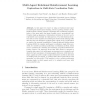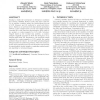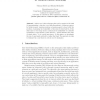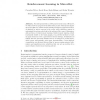114
Voted
ATAL
2004
Springer
15 years 5 months ago
2004
Springer
Multi-agent research often borrows from biology, where remarkable examples of collective intelligence may be found. One interesting example is ant colonies’ use of pheromones as...
119
click to vote
LAMAS
2005
Springer
15 years 6 months ago
2005
Springer
In this paper we report on using a relational state space in multi-agent reinforcement learning. There is growing evidence in the Reinforcement Learning research community that a r...
127
Voted
IWLCS
2005
Springer
15 years 6 months ago
2005
Springer
Aiming to clarify the convergence or divergence conditions for Learning Classifier System (LCS), this paper explores: (1) an extreme condition where the reinforcement process of ...
112
click to vote
ICCBR
2005
Springer
15 years 6 months ago
2005
Springer
CBR is one of the techniques that can be applied to the task of approximating a function over high-dimensional, continuous spaces. In Reinforcement Learning systems a learning agen...
112
click to vote
ICANN
2005
Springer
15 years 6 months ago
2005
Springer
For this special session of EU projects in the area of NeuroIT, we will review the progress of the MirrorBot project with special emphasis on its relation to reinforcement learning...
85
Voted
GECCO
2005
Springer
15 years 6 months ago
2005
Springer
Recurrent neural networks are theoretically capable of learning complex temporal sequences, but training them through gradient-descent is too slow and unstable for practical use i...
91
Voted
GECCO
2005
Springer
15 years 6 months ago
2005
Springer
The development of the XCS Learning Classifier System has produced a robust and stable implementation that performs competitively in direct-reward environments. Although investig...
ECML
2005
Springer
15 years 6 months ago
2005
Springer
Abstract. While direct, model-free reinforcement learning often performs better than model-based approaches in practice, only the latter have yet supported theoretical guarantees f...
AUSAI
2005
Springer
15 years 6 months ago
2005
Springer
: In order to scale to problems with large or continuous state-spaces, reinforcement learning algorithms need to be combined with function approximation techniques. The majority of...
118
click to vote
ATAL
2005
Springer
15 years 6 months ago
2005
Springer
This paper is concerned with how multi-agent reinforcement learning algorithms can practically be applied to real-life problems. Recently, a new coordinated multi-agent exploratio...





